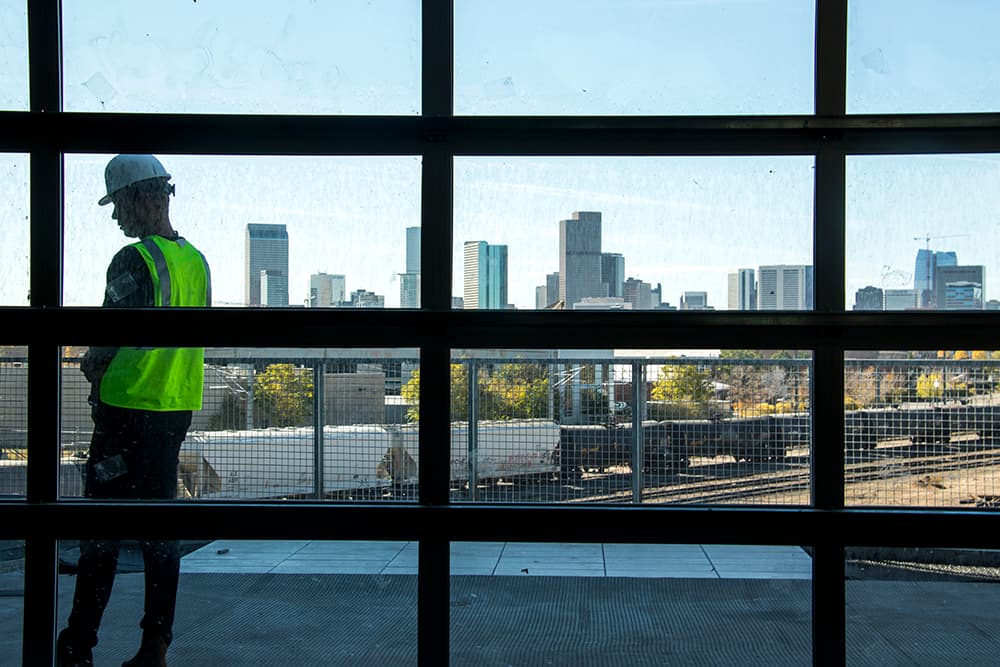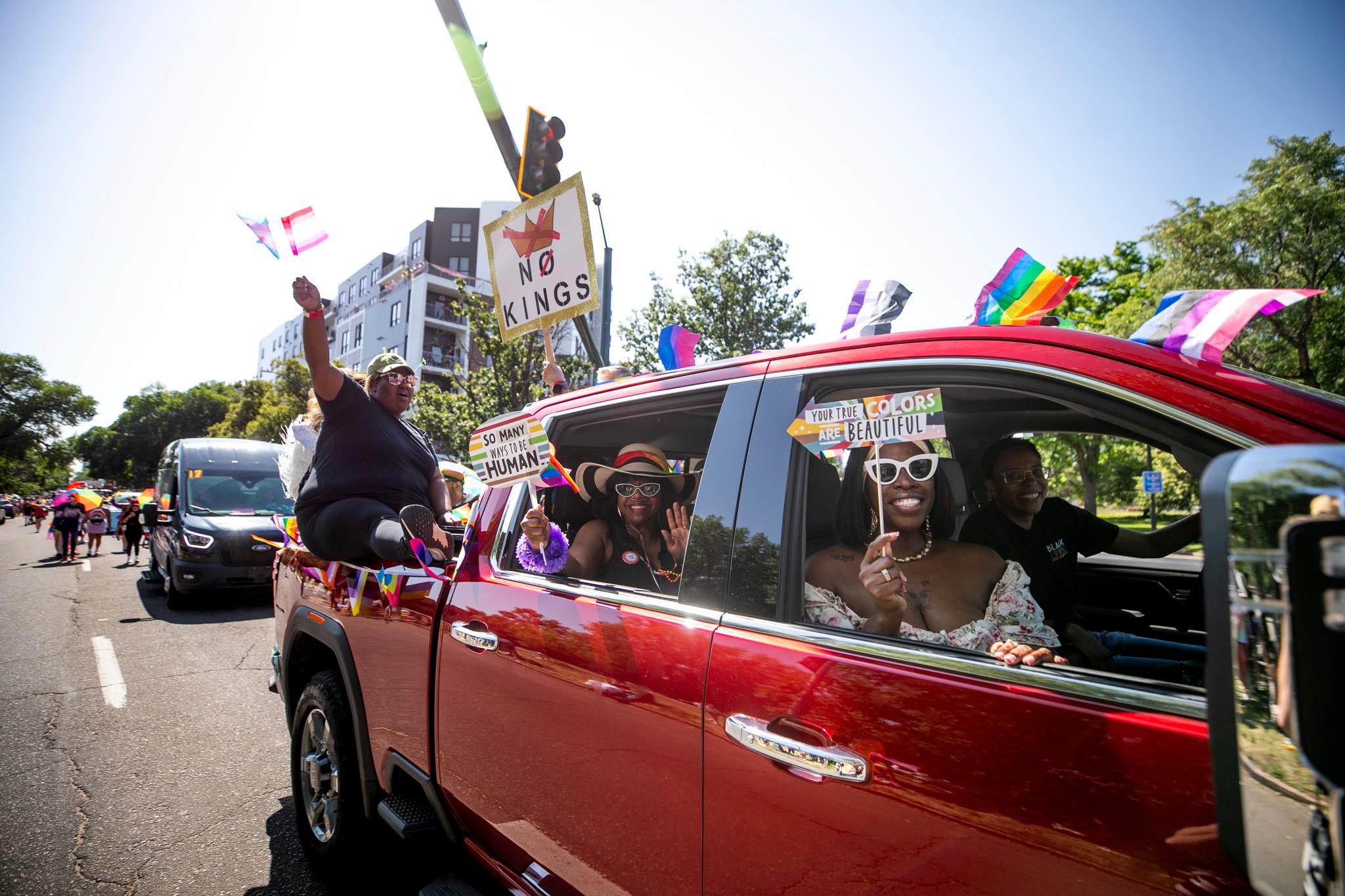Jamie Giellis was among the players at the ground level -- at the literal table inside offices around Brighton Boulevard, usually at Industry co-working -- when it was all being figured out.
Over the course of several months toward the end of 2014, she joined Brighton Boulevard property owners, developers and city officials to figure out how this promising north-central district would look, how it would be funded and how it would be maintained. She was working as a consultant at the time, focusing on design and costs.
Giellis, formerly the president of the RiNo Art District, calls it "one of the most fascinating and wonderful" city projects she was a part of, and she's helped consult for quite a few (see RiNo, Golden Triangle, Santa Fe Drive).
Also at the table was Zeppelin Development, the father-and-son company that owned key properties in the area. Years later, the company's top brass would later bankroll her unsuccessful mayoral campaign.
"I think the Zeppelins certainly brought some innovative principles that ended up in the design (of Brighton)," Giellis said.
As Kyle Zeppelin, the company's president, puts it, their buildings are meant to complement existing development and consider local input (which is by no means a unique approach in Denver). It's made them the chief architects of Brighton Boulevard in every sense of the word.
"So we've always had this, I don't know if it's a masochistic tendency," Zeppelin said jokingly. "But if you look at my dad's (development) history, it's the third major underused urban neighborhood. There's parallels between all of them, which is starting in LoDo in the mid-seventies, Golden Triangle in more like the late eighties, and now RiNo since 2000."
Andy Feinstein, a private developer and chairman of the RiNo Art District, said the Zeppelins "literally kicked off development" on the west side of the district.
"It's an epicenter for entrepreneurship and innovation," Feinstein said.
Zeppelin purchased its first property in the area in 2000.
Now the company has more than a handful: The Source and The Source Hotel on Brighton, Zeppelin Station on Wynkoop, and way more in the area.
Brad Segal, president at Denver-based Progressive Urban Management Associates, said the decision to buy around Brighton seemed odd at the time.
"A lot of people were scratching their heads. They didn't know what was going on," Segal said.
The eight-acre site is where the Taxi campus now lies. Zeppelin said at the time it was like a place without a neighborhood, a no-man's land filled mostly with junkyards. It may have felt that way to Zeppelin, but the corridor hosted about 80 homes before Brighton's boom.

"You had sites that were literally falling into the ground, a street without sidewalks," Zeppelin said. "There isn't as many people that have focused on this area up to this point. So we had somewhat of an ability to influence the character in ways that are more radical."
They saw an opportunity to use the Zeppelin formula. It's one Zeppelin describes as focusing on underused, former industrial sites and creating something new. But unlike work in previous neighborhoods, Segal said the developments near Brighton "caught on quicker than others." He credits this to trends, like younger people wanting to live in more urban environments.
"People don't get it. People who are in their 30s just assume stuff always looked like this," Segal said, adding, "Denver was a dump in the eighties ... Downtown had a bunch of pretty building from the oil boom but it was mostly dead after 5 p.m."
Zeppelin calls the area's current design "post-industrial."
It's a design he said wouldn't make sense in Lo-Hi, central Downtown or Cherry Creek. The Taxi campus includes office space, residential units and even places to eat, like Comal, a food incubator helping refugees and immigrants learn culinary skills.
"Our projects have never been limited to the building footprint, so the idea is to connect to the site around it, to provide a complement for the city around it," Zeppelin said. "But the main motivating factor is really to contribute to a higher-functioning city."
Zeppelin sees the Source -- which opened in 2013 and was developed with public financing -- as a catalyst for Brighton Boulevard. He said it showed there was "appetite" for spaces that gave people another way to experience different parts of the city. It ended up being a pioneering model for food halls that are now commonplace in the city.
Not that Brighton hasn't experienced growing pains. Zeppelin, a vocal critic of Mayor Michael Hancock, claims the administration's $32 million reconstruction of the street "killed virtually every business" on Brighton. While that may be a bit of an overstatement, business owners on the corridor were affected. Rebel Restaurant co-owner Bo Porytko blamed construction for the closing of his Wynkoop Street restaurant in 2018, according to Eater Denver.
"Some of those businesses will never come back," Zeppelin said. "So what you end up with is a new generation of businesses."
The makeover added sidewalks, bikeways, trees, benches and green infrastructure to a rotting street. Overall Zeppelin thinks the final product has helped bring more foot traffic. The improvements have garnered generally positive reviews from biking and pedestrian advocates.
"It's fun, it's engaging. So it is living up to the vision of what we hoped," Zeppelin said.
Feinstein said construction did hurt tenants along the street. He called the construction a "double-edged sword" and added that while he was sorry for the businesses that couldn't survive the disruption caused by the construction, anyone who relocates now would benefit from the improved streetscape.

"Anybody who develops on Brighton Boulevard or owns property on Brighton Boulevard should be forever grateful to the Hancock administration's commitment to Brighton Boulevard," Feinstein said.
Nola Miguel, director of the Globeville Elyria-Swansea Coalition, said the "RiNo movement" has had a pretty significant impact on her neighborhood and in Five Points.
Portions of the district are in Globeville, Elyria-Swansea and Five Points. The movement has contributed to higher home prices and displacement, according to Miguel. While Zeppelin's camp has said that developing industrial areas protects against the negative effects of gentrification.
Miguel commended the Zeppelins for projects like the Comal food incubator, but said she would like to see more done for locals.
"There isn't necessarily a proactive, continued relationship with that neighborhood," Miguel said. "There's new residents that they can cater to instead."
Miguel said a proactive relationship would mean ensuring locals in RiNo actually get a stake in the planning process, as opposed to simply being hired on as cleaning staff for offices. She's interested in seeing more partnerships providing steadier employment opportunities like the ones created by Comal.
Zeppelin Development attempted to build almost 200 affordable homes for families just off Brighton, but could not secure federal financing, BusinessDen reported in April. The homes will have one bedroom each and rent at market rates.
Segal credits much of the Zeppelin success in Brighton and elsewhere to Kyle's father, Mickey.
Segal worked with the elder Zeppelin while they helped develop LoDo. Segal, who's been involved in development for more than 30 years, said the Zeppelins seem to have a "sixth sense" when it comes to finding the next big thing in Denver development.
"Mickey was a pioneering visionary who called it right three times," Segal said.
Giellis had similar thoughts. She got closer to the Zeppelins when they began looking for potential mayoral candidates to challenge Hancock. Their relationship paved the way for Geillis to jump into the fray last November. The union came naturally, as Geillis said they shared views about stuff she "geeks out" on like urban planning, sustainability, transportation and bicycle infrastructure.
And perhaps more importantly, they shared frustration over the current mayoral administration. Brighton's transformation gave her the confidence to launch her run.
"One of the places where I, early on, got really interested in the Zeppelin philosophy is how we build Brighton Boulevard," Giellis said. She said the street isn't perfect, but Giellis credits ideas the Zeppelins championed like adding raise bike lanes and bioswales to the city as proof of innovation. "That really all came from a push to dream bigger and bolder for urban design."


RiNo Art District President and co-founder Tracy Weil has been in the area for nearly 20 years. He remembers a time when Brighton Boulevard was used by people trying to get downtown.
"There was no sensibility," Weil said. "It was really an area that was disregarded by the city. This area that was unsafe in some ways -- the lighting was terrible, it was definitely a tricky area to navigate ... it was a thoroughfare. Now traffic has slowed down, it let's people know they have arrived somewhere, there is a sense of place."
Weil said he was especially appreciative of the food hall because it gave him dining options beyond a Subway and the nearby 7-Eleven.
"I especially remember when the Zeppelins did the Source," Weil said. "It was really transformative of the area. It was one of the first projects on Brighton Boulevard that gave attention to that front door of Denver."













